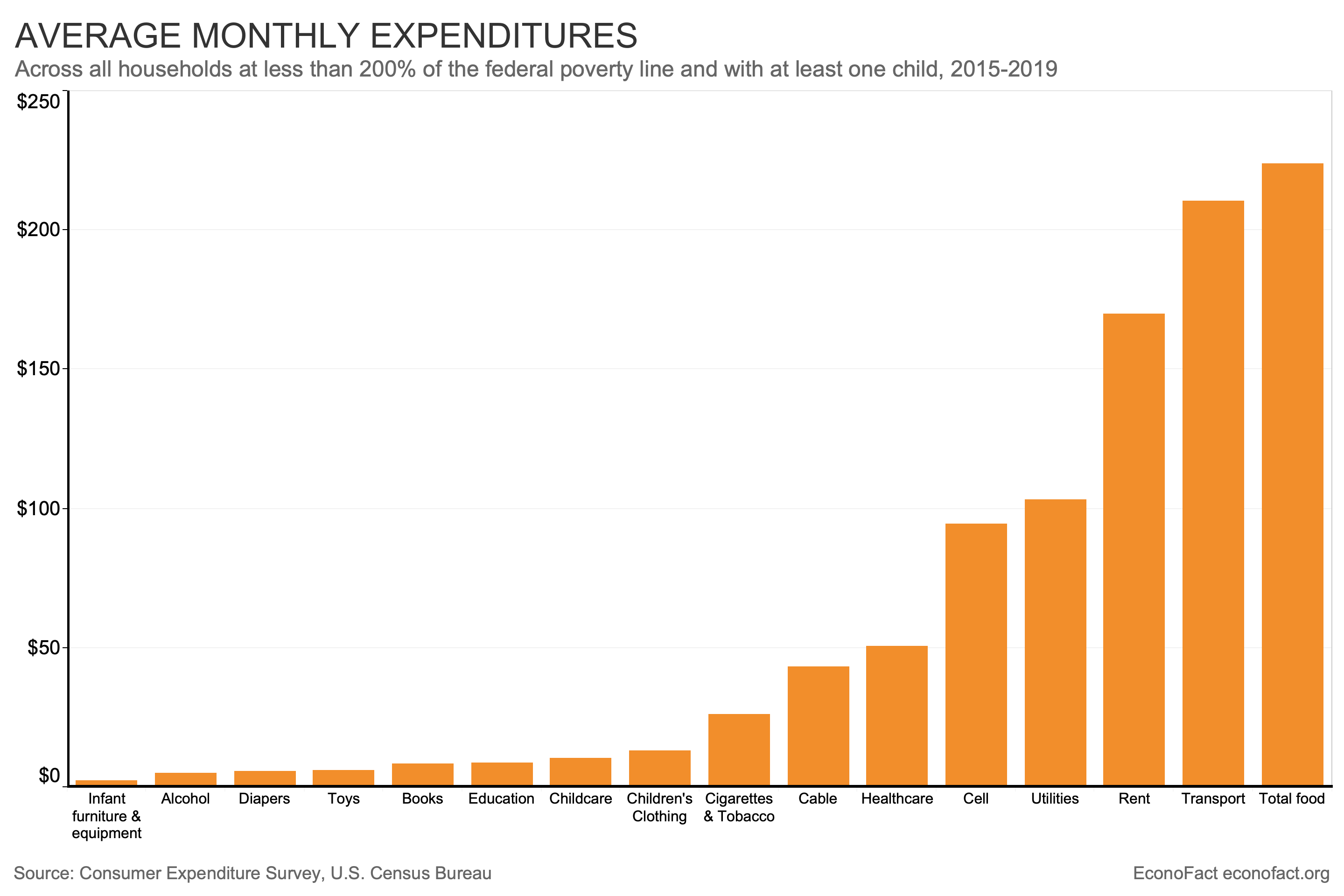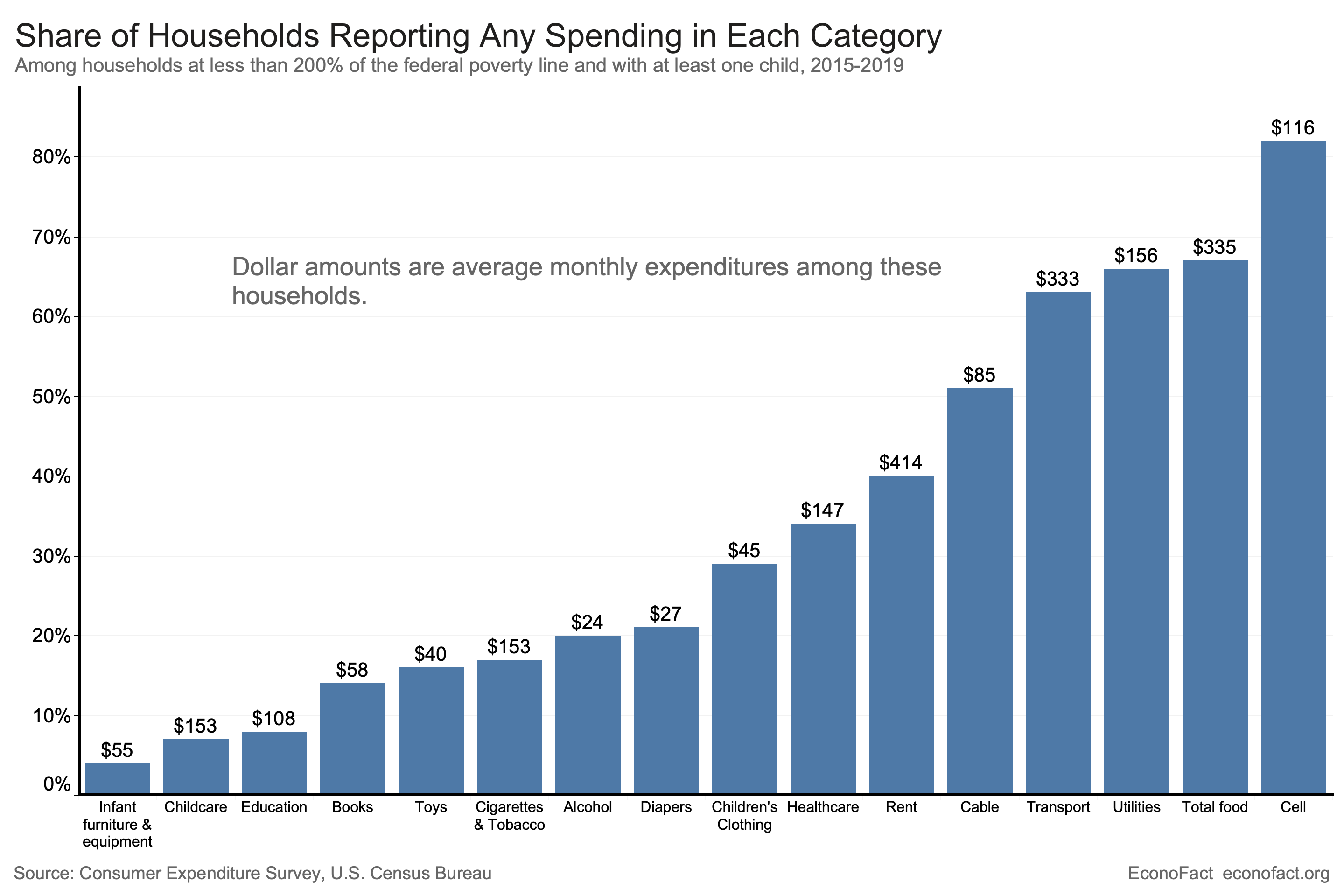What Do Poor People Spend Their Money On
Child Poverty
Child PovertyHow Do Low-Income Families Spend Their Money?
· November 15, 2021
Duke University and University of Texas at Austin
 (Click here for a larger version of the graph)
(Click here for a larger version of the graph)
The Issue:
Over x one thousand thousand American children —1 in 7— were living in poverty in 2019, as measured by the official U.Southward. poverty level. The proportion is even college for children younger than 6 and for Black, Latino, and American Indian children. Many of the programs in the U.S. social prophylactic net are specifically targeted to help families with children residing in poverty encounter core needs such as food, housing or health intendance. Examining the typical expenditures of families with children residing in poverty offers a fuller flick of how they classify their express funds and the extent to which government programs are available to cover costs of some of these necessities.
Nigh 75% of expenditures for families living in or virtually poverty goes to food, transportation, rent, utilities, and cellphone service.
The Facts:
- Families at the lower finish of the income distribution spend a substantial share of their income on core needs. Nosotros used the Consumer Expenditure Survey, which provides estimates of household expenditures from a nationally representative sample to examine how families residing in poverty or virtually poverty spent the money available to them over the flow 2015 to 2019. Nosotros focus on households with any child aged 18 or less living at or beneath 200% of the federal poverty line because this represents the upper threshold of eligibility for nigh safety net assistance. The specific income levels vary with family size and relationships of household members. (For reference, it was $42,660 for a family of iii in 2019.) On average, nearly 75% of the total expenditures for these families went to food, transportation, rent, utilities, and cellphone service (see nautical chart). This is in line with comparable analyses showing that families at the lower end of the income distribution spend a far greater share of their income on categories considered core needs relative to families in the eye or higher end of the income distribution (see here and here). In our assay, these spending allocations look similar for families residing in poverty beyond dissimilar racial and ethnic groups, including on expenses that directly benefit children, such equally childcare, education, and toys.
- In that location is government back up for spending by families residing in poverty on healthcare, food, utilities and housing. Government programs provide full or partial coverage for example for wellness care via Medicaid, food via the Special Supplemental Nutrition Program for Women, Infants, and Children (WIC) and the Supplemental Nutrition Assistance Plan (SNAP), utilities via the Low Income Abode Energy Assist Program LIHEAP, and housing via the Section eight housing choice voucher program.
- But aid is limited and there are gaps in coverage, which means that many of these families still accept out-of-pocket costs to cover bones categories. We find that two-thirds of the families reported spending out-of-pocket on utilities, and these make upwardly nearly 12 percent of average full monthly expenditures. Similarly, forty pct of the households in our data spent out-of-pocket money on rent, which took up about 30 pct of total boilerplate monthly expenditures for these families. This may exist due to a variety of factors. Income eligibility criteria may leave out some families whose income is to a higher place cutoff rates but still below twice the federal poverty line (for instance, household income must be at or below 130% of the poverty line to be eligible for SNAP). Some families may be ineligible because of difficulty coming together or providing required documentation to run into work requirements or because of household characteristics (e.chiliad. stricter requirements for a two-parent household, multi-generational households or households with members who exercise not have U.S. citizenship). Moreover, at that place is restricted availability of subsidies, which means that families that are eligible for assistance oftentimes have to embrace these costs while they expect for housing or childcare vouchers, for instance. And it may likewise be the case that subsidies are insufficient for households' needs.
- At that place is a wide degree of variation in the expenses families residing in poverty face. For example, out of pocket expenditures on health care – including insurance premiums, medical services, prescription drugs, and medical supplies – vary profoundly across families with children. Fifty-fifty though the bulk (66%) reported zero out of pocket wellness expenditures, the other 34% of families spend an average of $147 each month (see chart beneath). Similarly, the share of households that report out-of-pocket spending on childcare is quite low – merely 7 percent of families written report whatsoever out-of-pocket childcare expenditure. This likely reflects that some formal paid center-based intendance is typically subsidized through programs like Head Get-go, and because a lot of non-parental care is provided through unpaid breezy providers like relatives. All the same, those households that do report spending on childcare spend an average of $153 out of pocket each month — nearly 10% of total expenditures for these families.
 (Click here for a larger version of the graph)
(Click here for a larger version of the graph)
- At that place is very lilliputian targeted assistance for expenditures on transportation and applied science, which have become essential for current day-to-day life. Virtually 2-thirds (63%) of families reported spending out-of-pocket for transportation. These families spent 14% of their full expenditures on transportation costs at nearly $333 on average each month. Even though transportation is a primal expenditure for job memory and access to services, including healthcare, few family or individual level subsidies exist for families residing in poverty outside of broader government investments in transportation infrastructure such as bridges, roadways and public buses and trains. In fact, many government programs count the value of cars — considered an nugget — against eligibility determination for receipt of benefits. Additionally, mobile or smart phones are disquisitional for access to the Internet, likewise as a means for interacting with schools and kid health providers, accessing supports and services for children, and facilitating chore search, among many other necessary functions. Non surprisingly, more than four-fifths (82%) of families with children at or below 200 percentage of the poverty line spent coin on cellular service.
- Expenditures on children went beyond the very basic categories of nutrient, shelter, and health. Just under ane-fifth of families with children residing in or nigh poverty reported expending money on early learning materials; 14% of families spent on books, sixteen% on toys, and 8% on education (schoolbooks, supplies, and/or tuition). More than than ane-fifth (21%) of all families with children reported expenditures on diapers. This effigy increases to 60% if we only consider households that include a child nether 2, with an boilerplate monthly expenditure of $27 amidst such households that report spending on diapers. Very few families report spending on baby piece of furniture – just 4% overall and 13% of families with at least 1 kid under two.
- Spending on core needs, and on children, exceeds spending on booze or tobacco. About 1-fifth of families residing in poverty reported whatever household expenditure on alcohol, with a monthly average of $24 for those households. About one-6th reported any expenditure on cigarettes or tobacco, at a monthly average of $153. The finding that a relatively small portion of very low-income households spend whatsoever money at all on alcohol and cigarettes runs counter to some of the assumptions that have played a role in structuring aid programs for people residing in poverty in the United states; and, keep to be a thing of policy debate in considerations of unconditional cash benefits to families even though there is piddling empirical support for the merits that greenbacks transfers would translate into irresponsible spending.
Our assay shows that in spite of the prophylactic cyberspace programs that back up families residing in poverty, those living at or below twice the federal poverty line, devote a substantial share of their monthly expenditures to goods and services necessary for bones shelter, wellness, and nutrition. The data exercise not support claims of 'irresponsible' spending on alcohol or tobacco among these families. Even though many public programs at present rely on technology to get admission, social programs have not caught upwardly to the demands of contemporary daily life. Transportation, utilities, and expenses related to uptake and use of applied science are all key expenditures that impact quality of life, parenting, and economical opportunity, yet are not typically covered by government programs or subsidies. The data also suggest evidence of places where public subsidies may autumn well short of families' needs, such equally food costs. Families may have access to food through food pantries and informal back up through other means nosotros can't observe, and SNAP dollars brand up some of the food expenditures in our information. Still, more than two-thirds of families residing in or virtually poverty report sizable out-of-pocket nutrient expenses and households with children make up the largest share of households experiencing food insecurity in the United States. These facts speak to criticisms of the existing program's reliance on potentially outdated formulas inadequate to the food needs of a nowadays-day household with children.
Source: https://econofact.org/how-do-low-income-families-spend-their-money
Posted by: campbellhavot1998.blogspot.com

0 Response to "What Do Poor People Spend Their Money On"
Post a Comment